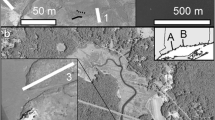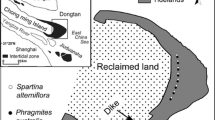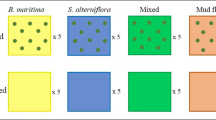Abstract
Intense herbivory by a growing population of intertidal burrowing crabs Sesarma reticulatum (purple marsh crabs) has denuded large areas of salt marsh on Cape Cod (Massachusetts, USA). Spartina alterniflora (smooth cordgrass) and, to a lesser extent, S. patens (salt marsh hay) have been the primary taxa affected while halophytic forb populations of Salicornia spp. (pickleweed), Suaeda maritima (sea-blite), and Limonium carolinianum (sea lavender), that normally constitute a relatively low proportion of marsh vegetation, have remained intact. In addition, these forb species appear to be colonizing some of the marsh grass dieback areas. Because the loss of vegetation results in considerable subsidence and erosion, the objective of this study was to (1) confirm whether certain taxa are unpalatable to S. reticulatum and (2) determine whether unpalatable species could be used to re-vegetate dieback areas as an interim measure to control marsh sediment and elevation loss. The results suggest that S. reticulatum prefers Spartina alterniflora over forbs and that one or all of these forb species are good candidates for vegetation restoration in dieback areas.






Similar content being viewed by others
References
Adam P (1993) Saltmarsh ecology. Cambridge University Press, NY, p 461
Alber M, Swenson EM, Adamowicz SC, Mendelssohn IA (2008) Salt marsh dieback: an overview of recent events in the US. Estuar Coast Shelf Sci 80:1–11
Alberti J, Escapa M, Iribarne O, Silliman BR, Bertness MD (2008) Crab herbivory regulates plant facilitative and competitive processes in Argentinean marshes. Ecology 89:155–164
Altieri AH, Bertness MD, Coverdale TC, Herrmann NC, Angelini C (2012) A trophic cascade triggers collapse of a salt-marsh ecosystem with intensive recreational fishing. Ecology 93:1402–1410
Armitage AR, Boyer KE, Vance RR, Ambrose RF (2006) Restoring assemblages of salt marsh halophytes in the presence of a rapidly colonizing dominant species. Wetlands 26:667–676
Baltzer JL, Reekie EG, Hewlin HL, Taylor PD, Boates JS (2002) Impact of flower harvesting on the salt marsh plant Limonium carolinianum. Can J Bot 80:841–851
Bertness MD (1988) Peat accumulation and the success of marsh plants. Ecology 69:703–713
Bertness MD, Ellison AM (1987) Determinants of pattern in a New England salt marsh plant community. Ecol Monogr 57:129–147
Boorman LA, Garbutt A, Barratt D (1998) The role of vegetation in determining patterns of the accretion of salt marsh sediment. In: Black KS, Paterson DM, CrampA (eds) Sedimentary processes in the intertidal zone, vol 139. Geol Soc Lond Spec Publ, pp 389–399
Boucaud J, Ungar IA (1986) Influence of hormonal treatments on the growth of two halophytic species of Suaeda. Am J Bot 63:694–699
Boyer KE, Fong P, Vance RR, Ambrose RF (2001) Salicornia virginica in a southern California saltmarsh: seasonal patterns and a nutrient enrichment experiment. Wetlands 21:315–326
Brown SC, Bedford BL (1997) Restoration of wetland vegetation with transplanted wetland soil: an experimental study. Wetlands 17:424–437
Bruno JF (2000) Facilitation of cobble beach plant communities through habitat modification by Spartina alterniflora. Ecology 81:1179–1192
Buchsbaum R, Valiela I, Swain T (1984) The role of phenolic compounds and other plant constituents in feeding by Canada geese in a coastal marsh. Oecologia 63:343–349
Cahoon DR, Lynch JC, Powell AN (1996) Marsh vertical accretion in a Southern California Estuary, U.S.A. Estuar Coast Shelf Sci 43:19–32
Cameron GN (1972) Analysis of insect trophic diversity in two salt marsh communities. Ecology 53:58–73
Castillo JM, Luque CJ, Castellanos EM, Figureoa ME (2000) Causes and consequences of salt-marsh erosion in an Atlantic estuary in SW Spain. J Coast Conserv 6:89–96
Christiansen T (2000) Flow and sediment transport on a tidal salt marsh surface. Estuar Coast Shelf Sci 50:315–331
Egan TP, Ungar IA (2000) Similarity between seed banks and aboveground vegetation along a salinity gradient. J Veg Sci 11:189–194
Ehrenfeld JG (1990) Dynamics and processes of barrier island vegetation. Rev Aquat Sci 2:437–480
Ellison AM (1987) Effects of competition, disturbance, and herbivory on Salicornia europaea. Ecology 68:576–586
Erfanzadeh R, Garbutt A, Pétillon J, Maelfait JP, Hoffmann M (2010) Factors affecting the success of early salt-marsh colonizers: seed availability rather than site suitability and dispersal traits. Plant Ecol 206:335–347
Ewanchuk PJ, Bertness MD (2004) The role of waterlogging in maintaining forb pannes in northern New England salt marshes. Ecology 85:1568–1574
Frumhoff PC, McCarthy JJ, Melillo JM, Moser SC, Wuebbles DJ (2007) Confronting climate change in the U.S. northeast: science, impacts, and solutions. Synthesis report of the Northeast Climate Impacts Assessment (NECIA). Union of Concerned Scientists (UCS), Cambridge
Gedan KB, Kirwan ML, Wolanski E, Barbier EB, Silliman BR (2011) The present and future role of coastal wetland vegetation in protecting shorelines: answering recent challenges to the paradigm. Clim Change 106:7–29
Gerdol V, Hughes KG (1993) Effect of the amiphipod Corophium volutator on the colonization of mud by the halophyte Salicornia europaea. Mar Ecol Prog Ser 97:61–63
Handa IT, Jeffries RL (2000) Assisted revegetation trials in degraded salt-marshes. J Appl Ecol 37:944–958
Harper JL (1977) Population biology of plants. Academic, London, p 892
He Q, Cui BS, Cai YZ, Deng JF, Sun T, Yang ZF (2009) What confines an annual plant to two separate zones along coastal topographic gradients? Hydrobiology 630:327–340
Holdredge C, Bertness MD, Altieri AH (2009) Role of crab herbivory in die-off of New England salt marshes. Conserv Biol 23:672–679
Hopkins DR, Parker VT (1984) A study of the seed bank of a salt marsh in northern San Francisco Bay. Am J Bot 71:348–355
Houwing E-J, van Duin WE, Van der Waaij YS, Dijkema KS, Terwindt JHJ (1999) Biological and abiotic factors influencing the settlement and survival of Salicornia dolichostachya in the intertidal pioneer zone. Mangr Salt Marsh 3:197–206
Huiskes AHL, Koutstaal BP, Herman PMJ, Beeftink WG, Markusse MM, de Munck W (1995) Seed dispersal of halophytes in tidal salt marshes. J Ecol 83:559–567
Joenje W (1985) The significance of waterfowl grazing in the primary vegetation succession on embanked sandflats. Vegetatio 62:399–406
Kennish MJ (2001) Coastal salt marsh systems in the U.S.: a review of anthropogenic impacts. J Coast Res 17:731–748
Khan MA, Ungar IA (1985) The role of hormones in regulating the germination of polymorphic seeds and early seedling growth of Atriplex triangularis Willd. under saline conditions. Physiol Plant 63:109–113
Kirwan ML, Murray AB (2007) A coupled geomorphic and ecological model of tidal marsh evolution. Proc Natl Acad Sci USA 104:6118–6122
Kirwan ML, Murray AB, Boyd WS (2008) Temporary vegetation disturbance as an explanation for permanent loss of tidal wetlands. Geophys Res Lett 35:L05403
Kristensen DK, Kristensen E, Mangion P (2010) Food partitioning of leaf-eating mangrove crabs (Sesarminae): experimental and stable isotope evidence. Estuar Coast Shelf Sci 87:583–590
Leonard LA, Luther ME (1995) Flow hydrodynamics in tidal marsh canopies. Limnol Oceanogr 40:1474–1484
Li H, Yang SL (2009) Trapping effect of tidal marsh vegetation on suspended sediment, Yangtze Delta. J Coast Res 25:915–924
Llewellyn DW, Shaffer GP (1993) Marsh restoration in the presence of intense herbivory: the role of Justicia lanceolata Small. Wetlands 13:176–184
Neumeier U, Amos CL (2006) The influence of vegetation on turbulence and flow velocities in European salt-marshes. Sedimentology 53:259–277
Nishihiro J, Nishihiro MI, Washitani I (2006) Restoration of wetland vegetation using soil seed banks: lessons from a project in Lake Kasumigaura, Japan. Land Ecol Eng 2:171–176
Nordhaus I, Salewski T, Jennerjahn TC (2011) Food preferences of mangrove crabs related to leaf nitrogen compounds in the Segara Anakan Lagoon, Java, Indonesia. J Sea Res 55:414–426
Parker JD, Montoya JP, Hay ME (2008) A specialist detritivore links Spartina alterniflora to salt marsh food webs. Mar Ecol Prog Ser 364:87–95
Pennings SC, Callaway RM (1992) Salt marsh plant zonation: the relative importance of competition and physical factors. Ecology 73:681–690
Pennings SC, Carefoot TH, Siska EL, Chase ME, Page TA (1998) Feeding preferences of a generalist salt-marsh crab: relative importance of multiple plant traits. Ecology 79:1968–1979
Pennings SC, Siska EL, Bertness MD (2001) Latitudinal differences in plant palatability in Atlantic Coast salt marshes. Ecology 82:1344–1359
Rand TA (2000) Seed dispersal, habitat suitability and the distribution of halophytes across a salt marsh tidal gradient. J Ecol 88:608–621
Ravens TM, Thomas RC, Roberts KA, Santschi PH (2009) Causes of salt marsh erosion in Galveston Bay, Texas. J Coast Res 25:265–272
Rosencranz JA (2012) Accretion, sediment deposition and suspended sediment dynamics in Mugu Lagoon, a southern California coastal estuary. MS Thesis, University of California, Los Angeles
Rowcliffe JM, Watkinson AR, Sutherland WJ (1998) Aggregative responses of Brant geese on salt marsh and their impact on plant community dynamics. Oecologia 114:417–426
Shahba MA, Qian YL, Lair KD (2008) Improving seed germination of saltgrass under saline conditions. Crop Sci 48:756–762
Silliman BR, van de Koppel J, Bertness MD, Stanton L, Mendelsohn I (2005) Drought, snails, and large-scale die-off of southern U.S. salt marshes. Science 310:1803–1806
Smith SM (2009) Multi-decadal changes in salt marshes of Cape Cod, Massachusetts: a photographic analysis of vegetation loss, species shifts, and geomorphic change. Northeast Nat 16:183–208
Smith SM, Tyrrell MC (2012) Effects of mud fiddler crabs (Uca pugnax) on the recruitment of halophyte seedlings in salt marsh dieback areas of Cape Cod (Massachusetts, USA). Ecol Res 27:233–237
Smith SM, Medeiros KC, Tyrrell MC (2012) Hydrology, herbivory, and the decline of Spartina patens (Aiton) Muhl. in outer Cape Cod salt marshes (Massachusetts, U.S.A.). J Coast Res 28:602–612
Stalter R, Batson WT (1969) Transplantation of salt marsh vegetation, Georgetown, South Carolina. Ecology 50:1087–1089
Stralberg D, Brennan M, Callaway JC, Wood JK, Schile LM, Jongsomjit D, Kelly M, Parker VT, Crooks S (2011) Evaluating tidal marsh sustainability in the face of sea-level rise: a hybrid modeling approach applied to San Francisco Bay. PLoS ONE 6:e27388. doi:10.1371/journal.pone.0027388
Sullivan G (2001) Establishing vegetation in restored and created coastal wetlands. In: Zedler JB (ed) Handbook for restoring tidal wetlands. CRC Press, New York, pp 119–155
Takagawa S, Nishihiro J, Washitani I (1999) Safe sites for establishment of Nymphoides peltata seedlings for recovering the population from the soil seed bank. Ecol Res 20:661–667
Talley TS, Levin LA (1999) Macrofaunal succession and community structure in Salicornia marshes of southern California. Estuar Coast Shelf Sci 49:713–731
Tessier M, Gloaguen JC, Lefeuvre JC (2000) Factors affecting the population dynamics of Suaeda maritima at initial stages of development. Plant Ecol 147:193–203
Tessier M, Gloaguen JC, Bouchard V (2002) The role of spatio-temporal heterogeneity in the establishment and maintenance of Suaeda maritima in salt marshes. J Veg Sci 13:115–122
Thomsen D, Marsden ID, Sparrow AD (2005) A field experiment to assess the transplant success of saltmarsh plants into tidal wetlands. Wet Ecol Manag 13:489–497
Thongtham N, Kristensen E (2005) Carbon and nitrogen balance of leaf-eating sesarmid crabs (Neoepisesarma versicolor) offered different food sources. Estuar Coast Shelf Sci 65:213–222
Troyo-Diéguez E, Ortega-Rubio A, Maya Y, León JL (1993) The effect of environmental conditions on the growth and development of the oilseed halophyte Salicornia bigelovii Torr. in arid Baja California Sur. México. J Arid Environ 28:207–213
van de Plassche O, Erkens G, Van Vliet F, Brandsma J, Van der Borg RJ, De Jong AFM (2006) Salt-marsh erosion associated with hurricane landfall in southern New England in the fifteenth and seventeenth centuries. Geology 34:829–832
van Eerdt MM (1985) The influence of vegetation on erosion and accretion in salt marshes of the Oosterschelde, The Netherlands. Vegetatio 62:367–373
Wetson AM, Zörb C, John EA, Flowers TJ (2012) High phenotypic plasticity of Suaeda maritima observed under hypoxic conditions in relation to its physiological basis. Ann Bot 109:1027–1036
Wolters M, Garbutt A, Bakker JP (2005a) Plant Colonization after managed realignment: the relative importance of diaspore dispersal. J Appl Ecol 42:770–777
Wolters M, Bakker JP, Bertness MD, Jefferies RL, Möller I (2005b) Salt-marsh erosion and restoration in south-east England: squeezing the evidence requires realignment. J Appl Ecol 42:844–851
Wolters M, Garbutt A, Bekker RM, Bakker JP, Carey PD (2008) Restoration of salt-marsh vegetation in relation to site suitability, species pool and dispersal traits. J Appl Ecol 45:904–912
Acknowledgments
This work was supported by the National Park Service’s Atlantic Research Center at Cape Cod National Seashore.
Author information
Authors and Affiliations
Corresponding author
Rights and permissions
About this article
Cite this article
Smith, S.M., Tyrrell, M.C. & Congretel, M. Palatability of salt marsh forbs and grasses to the purple marsh crab (Sesarma reticulatum) and the potential for re-vegetation of herbivory-induced salt marsh dieback areas in cape cod (Massachusetts, USA). Wetlands Ecol Manage 21, 263–275 (2013). https://doi.org/10.1007/s11273-013-9298-2
Received:
Accepted:
Published:
Issue Date:
DOI: https://doi.org/10.1007/s11273-013-9298-2




